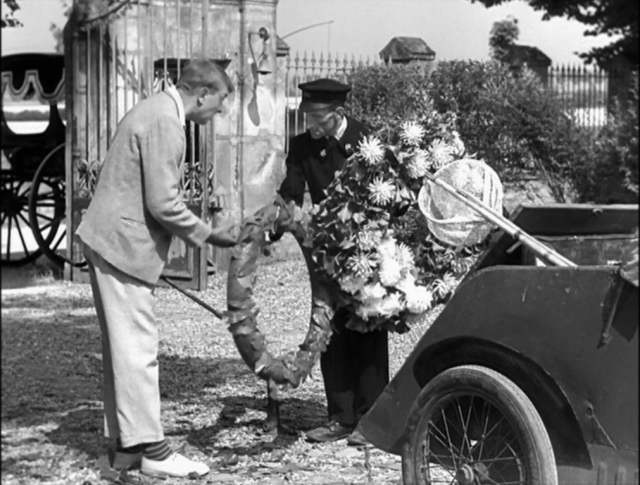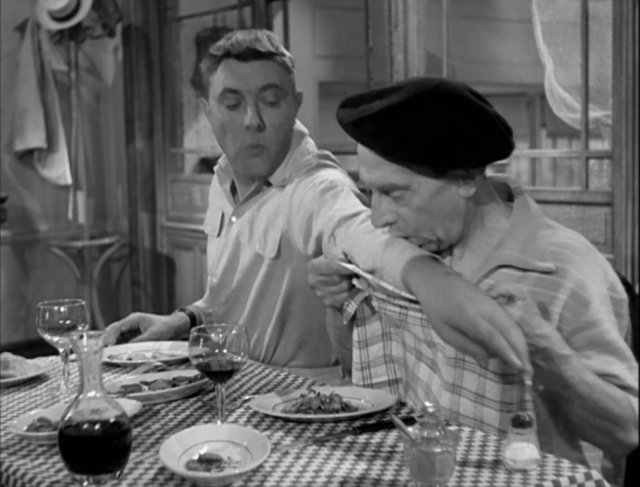
One for the deceased gentleman, and one for his hearse.
Jacques Tati’s second major film as a director, Les Vacances de Monsieur Hulot (M. Hulot’s Holiday), was released in 1953. This was the first to feature the character of Monsuier Hulot, a quirky everyman, who jauntily bumbles his way through a series of humorous episodes. Usually, the humor comes from Hulot’s unselfconscious way of disrupting the order of his environment, merely by being himself.
The obvious comparison for Tati, from my experience, is Chaplin. Just as in the films of the famous silent comic, Jacques Tati is the total filmmaker: a writer-director-actor who controls all the elements of his production. He has also created a comic persona in Monsieur Hulot, that—like Chaplin’s little tramp—is one of the great and iconic contributions to cinema. I have heard so much about the work of Tati, and now that I have finally seen the first of his films featuring M. Hulot, I know that the consensus is right—Tati is among the greatest filmmakers in world cinema history, and I am very excitedly looking forward to experiencing his other films.

Hulot, preparing his Jaws costume.
What makes him a great filmmaker, and not just a great comic, though? It is for me the complete mastery of his materials. One beautifully composed shot follows another, and when the camera moves, it is just the right amount, a delicacy and precision that isn’t fussy, but tastefully restrained. He keeps the simplicity of his resort setting fresh throughout the film by offering an expressive variety of perfectly chosen camera angles—always, as David Ehrenstein points out, in medium or full shots, never in close-ups. David Cairns summed up the visual artistry of Tati’s comic direction in this way:
The perfect visual gag unfolds in a single shot. Editing violates the spatiotemporal continuity, and although it may make trickery possible, it destroys the pure experience of seeing something unfold as if it were real. This need for simplicity increases the difficulty of the filmmaker’s task. If the camera is the perfect distance from the action, the composition and the very space around the performer can become sources of comedy in themselves. But if the camera is too distant or the details too subtle or the surrounding action too distracting, the whole point of the joke can easily be lost.
On the one hand, M. Hulot’s Holiday could have easily been a silent film. What little dialogue is present could have been presented on title cards, or even been ignored completely, with small loss to the picture. But the sound design, including the particular choices of music and the levels of certain sound effects, is very important to the overall effect. Some of the gags are even structured around the music, as with the record-player scenes.

Look out below!
A major difference between this film, and the well know Chaplin masterpieces, is that Hulot is never the sole center of attention in the film, or not for very long. The other characters on holiday are as much a source of Tati’s gentle, observational style of humor, as is the more clown-like Hulot, with his strange postures and stork-like manner of prancing on tiptoe wherever he goes. And many quiet moments where the camera tracks children, or a strolling middle-aged couple, serve not only to establish the setting, but also to create the atmosphere for the gags, which are typically more amusing than uprorious. As Roger Ebert described it, “It is not a comedy of hilarity but a comedy of memory, nostalgia, fondness and good cheer.”
A film of so few words can be difficult to write about, because it communicates in images rather than the concrete ideas and themes that language can burden a film with. It is a purer form of cinema, paradoxically gaining a specific resonance despite its abstraction. I think we can all relate to the exasperated waiters, the harried holiday-takers, and even the clown Hulot, from different moments in our own lives. And so that “memory” that Ebert speaks of is evoked, and the “fondness” for these characters arises as we recall these same feelings. That Tati achieves this without really a hint of sarcasm or meanness is maybe his most refreshing virtue, in an era where comedy almost always means the crudest and loudest possible expressions.

Hulot, a model of efficiency and neighborliness, offers his arm as a napkin while reaching for the salt.
This post is part of the Blind Spot 2017 series, hosted by Ryan McNeil at The Matinee.

A lovely account of a favorite movie. Welcome to the Tati club!
LikeLike
Thanks!
LikeLike
Yes, exactly – Tati has fondness and a gentle humour and is never mean or sarcastic. These qualities make the film feel fresh, as though you yourself have been on vacation.
I liked that you talked about the brilliant sound design. It would NEVER occur to me to create the “dialogue” that way.
LikeLiked by 1 person
It was a lovely film, and I’m really eager to see more of his films in the future.
LikeLiked by 1 person